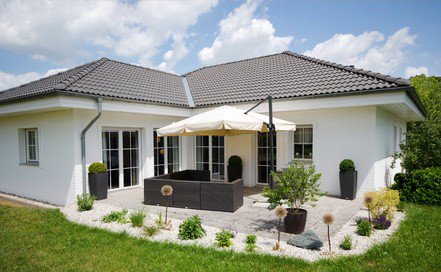On the way to your own prefabricated house, sooner or later a central question arises: aim high or rather stay on the carpet? If you like to keep both feet on the ground, you should probably opt for a bungalow. We explain here who the small energy miracle is particularly suitable for, what prices can be expected for a bungalow prefabricated house and what you have to look out for when buying.
the essentials in brief
People with mobility problems and families with small children particularly appreciate the ground-level construction.Prefab bungalows are also suitable for small budgets.
With geothermal and solar energy, bungalows protect the environment and keep electricity and hot water costs low.
Holiday flair in your own home
Whoever hears the word “bungalow” often thinks of summer, beaches and sunshine. More and more future homeowners are discovering this type of house not only as a holiday home, but also as a permanent home, because in reality it looks good all year round.
In fact, the low-rise building has its origins in a country with permanent holiday temperatures: it originated in subtropical India. But also in Germany, the bungalow has had a firm place in the hearts of architecture lovers since the 1950s – and thus also in the repertoire of prefabricated house suppliers! Above all, the low entry-level prices make this type of house an attractive alternative to a solid house for prospective builders: the cheapest variants are available from €75,000. But what actually distinguishes a bungalow from other houses?
By definition, a bungalow is a single-storey detached house. It usually gets its characteristic minimalist silhouette from a flat roof, but versions with a pent or hipped roof are also becoming increasingly popular thanks to the additional storage space. Optional basement floors also offer a welcome opportunity to accommodate heating and other necessary house connections out of sight.
However, the central feature remains: in the bungalow, the living spaces are on a single level. And that brings decisive advantages.

Ideal for all generations
It doesn’t matter whether you’re a newly founded family or a newly retired person – a bungalow is the perfect home for young and old. In multi-storey houses, stairs often pose a risk, both for the disabled and the elderly, as well as for the youngest. Living in a bungalow, on the other hand, is barrier-free and is therefore very suitable for all those who want to avoid the risk factor of stairs.
Large window fronts, through which a lot of light can enter, and quick access to the garden often ensure a good mood. There are no limits to creativity when it comes to the floor plan: A bungalow allows the rooms to be distributed individually without having to consider a second floor and the associated restrictions. So nothing stands in the way of a modern room concept.
When planning your own prefab bungalow, you should not forget that a ground-level floor plan naturally requires a larger plot of land. In comparison to a two-storey terraced house, at least twice as much floor space and twice as much roof space is required. Therefore, when varying the size of a bungalow concept, prices rise faster than when varying a multi-storey house.
In addition, there is the rather impractical relationship between living and outdoor space, which should not be ignored when considering energy standards and thermal insulation. This could require better insulation of the building envelope, which in turn entails slightly higher material costs. However, what a bungalow demands in terms of acquisition costs here, it makes up for elsewhere.
The large floor and roof area makes the house a favorite for environmentally conscious builders: geothermal surface collectors and photovoltaic systems can be installed here, which supply the home with hot water and electricity. Supported by heat pumps and controlled living space ventilation with heat recovery, the bungalow offers the perfect green energy concept, making its owners independent of electricity price fluctuations and coal-fired power plants.
So a bungalow?
Bungalows are the ideal home for young and old. There are prefab bungalows available from as little as €75,000, but variants with higher prices are usually a worthwhile investment: They convince with environmentally friendly and economical energy concepts.




